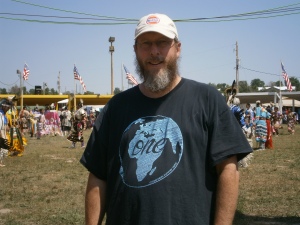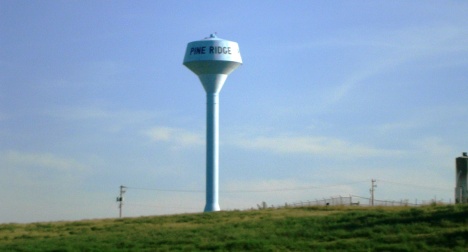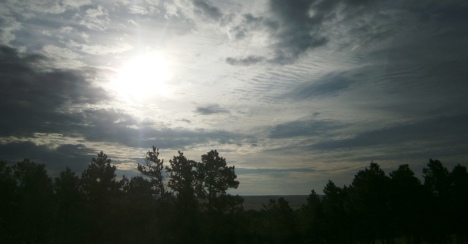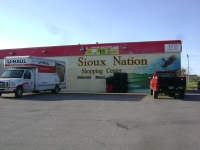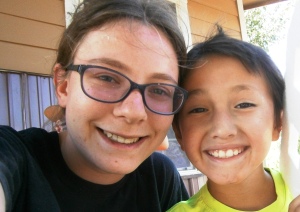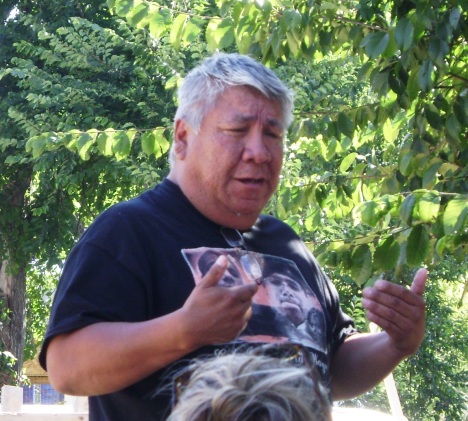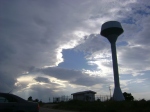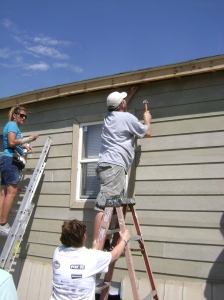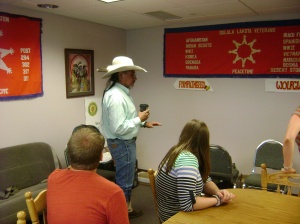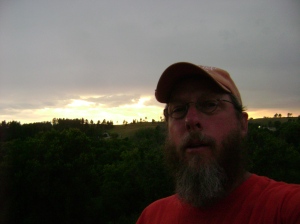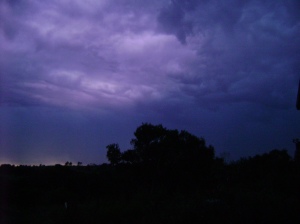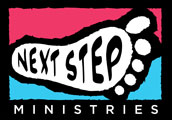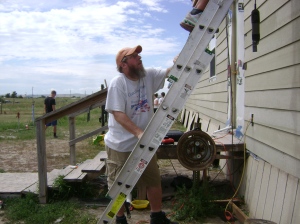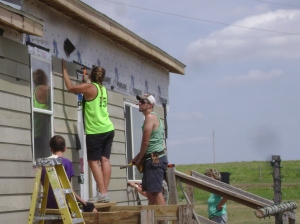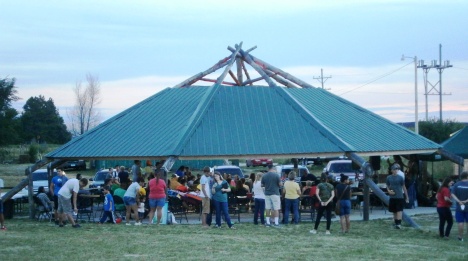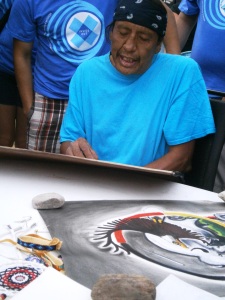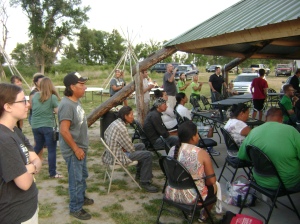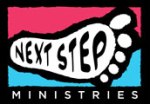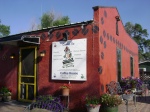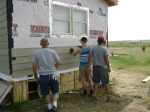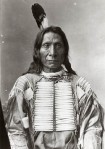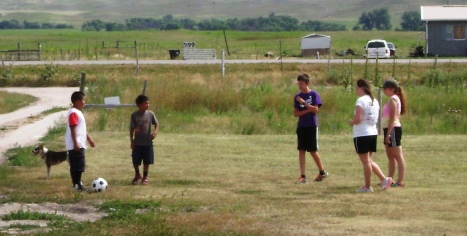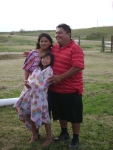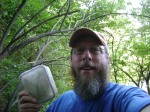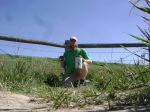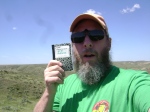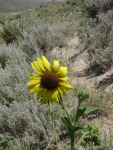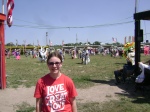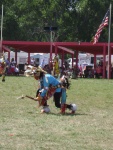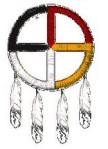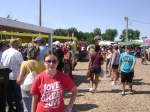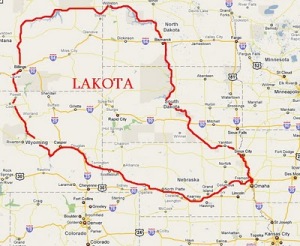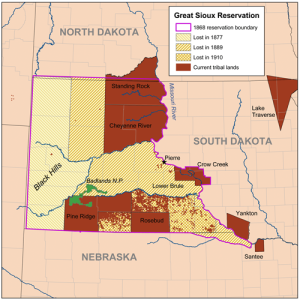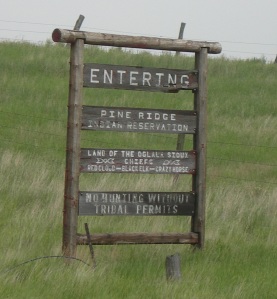Friday was the last full day we spent at Pine Ridge. It was our “free day” – no construction work was scheduled. Most groups went to Badlands National Park, Mount Rushmore, or the Black Hills. We spent most of the day meeting with people and building relationships.
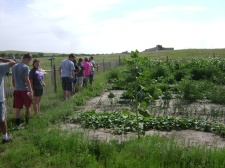
Ruby’s Garden
Our first stop was at the home of a Lakota woman named Ruby. Ruby lives in a trailer on the outskirts of the town of Pine Ridge, near the airport. She works to bring the message of the Gospel to the people of Pine Ridge in a number of ways. Ruby has a large garden where she grows a variety of vegetables, and she gives most of the produce away. One of the things I had noticed yesterday when I had visited the only grocery store in town was that the price of produce was extremely high. The government commodity foods that most of the residents receive contain very little fresh produce, and since most residents have extremely limited income, it must be very difficult for many residents to obtain fresh produce. Ruby’s garden helps with this.
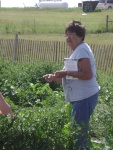
Ruby
Ruby also brings in a local Gospel band to do concerts, sometimes under a tent in her yard. She said that most Lakota won’t come to hear a speaker, but will come to hear music, and the message of Jesus Christ can be spread through music.
Ruby’s main income is her Social Security check, which she spends mostly to help others. She said, “I’m very poor materialistically, but very rich in God’s blessings.” Such a wonderful attitude!
Some of the guys grabbed lawnmowers and mowed Ruby’s yard.
Our next stop was at the Our Lady of Lourdes Catholic Cemetery in Porcupine, SD, to visit the grave of Cody White Pipe.
Many from our group met Cody, a 21-year-old Lakota man, a year ago while on another mission trip to Pine Ridge. Cody was hitch hiking, and they gave him a ride. Some of the group spent time getting to know him, and they became friends. About a month later, after the Fairfield group had returned home, Cody was killed in a hit-and-run accident. He had been visiting his sister, and had decided to walk home. His body was found on the side of U.S. Highway 18 about five miles east of Vetal, according to the Rapid City Journal. Cody’s obituary is here.
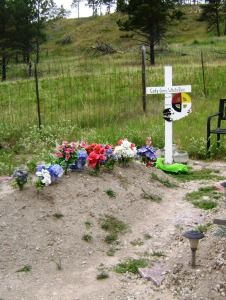
Cody’s Grave
Jessica, our group leader, went to Cody’s wake, and befriended several family members.
We were met at Cody’s grave site by his sister. She told us that Cody’s case is still considered open by the police, and that he might have been a victim of homicide. Apparently, there were indications at the scene that his death might not have been an accident. For many years, Pine Ridge Reservation has had a homicide rate much higher than the national average, and many of the murders remain unsolved. Gang violence is responsible for many of the murders. Although Cody was not affiliated with any of the gangs on the reservation, Cody’s family suspects that he might have seen something, or said something, or been mistaken for someone else, and paid for it with his life.
According to his sister, Cody had mentioned seeing a mysterious, dark figure a week or so before his death. Many Lakota believe in a “Tall Man” spirit, a spirit of death, which often appears to people before they die. Because Lakota religion is based around spirit worship, demonic activity is rampant on the reservation. It’s quite possible Cody’s death was influenced by this demonic activity.
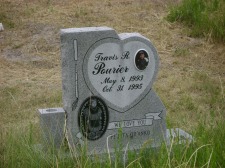
Grave of a young Lakota child
Something that struck me as I walked around the cemetery was the large number of young people and children buried there. There are many graves of infants, children, teenagers, and young adults in their 20s, far more than in most cemeteries I’ve visited. I’ve seen graves of children in pioneer cemeteries from the 1700s and 1800s, before modern medicine had been developed. These graves, however, were mostly from within the last 50 years. It really hit home to me how the medical care and relative safety I take for granted are simply not available to many on Pine Ridge Reservation, with deadly consequences. Pine Ridge has the lowest average life expectancy in the United States, largely because of childhood deaths. The problems with poverty on Pine Ridge and many other reservations have little to do with the current welfare system, but stem from treaties signed in the 1800s that have never been fully honored and never been renegotiated or revised. This has led to conditions comparable to third-world countries like Haiti, in the heartland of the United States.
As we were getting ready to leave the cemetery, Cody’s mother and other sister arrived. This other sister is the young lady we had met at Big Bat’s earlier in the week; she is currently homeless, living in a car with her three children. She recently bought a trailer, not far from the cemetery, for $400. We drove over to take a look at it.
The trailer had recently been used as a meth lab – there was drug paraphernalia and lab equipment strewn around. The interior had been completely stripped, the windows were all broken, and the drywall and insulation were gone. There was mold, dry rot, no plumbing, and no electric. The trailer was completely uninhabitable, even by Pine Ridge standards.
My daughter Stacey and I, along with at least one other person from our group, sensed something strange in and around the trailer. I went into the trailer, and was looking around, when I felt very strongly like I was being watched, like someone or something was hiding nearby. It freaked me out – I had to get out of the trailer immediately. Stacey said she sensed an evil “presence.” Neither Stacey nor I saw anything, but we sensed it. I’ve had this sort of sensation a few times before. In college, I used to get the same feeling every time a certain girl was around – even when I didn’t know she was there. It turned out, she was very heavily into the occult and witchcraft. Stacey and I both believe that there was some sort of demon in or near the trailer. Most of the people in our group said they didn’t see or sense anything unusual, but I’m sure there was something there. I realize some of my readers think demons are nonsense; however, as a follower of Jesus Christ, I believe demons are real. I don’t fear them, because the Holy Spirit dwells in me and protects me. However, they’re not something to be messed with, and for non-Christians, they can be extremely dangerous.
The general consensus among the adults in our group was that the trailer either needed to be completely dismantled and replaced, or that it would need a complete overhaul before it would be inhabitable. We were uncertain what, if anything, we could do to help get it to a livable condition before winter.
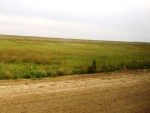
Middle of Nowhere
Our next stop of the day did involve a little sightseeing. We drove to a roadside pull-off overlooking the Badlands on BIA-41 between the town of Oglala and Red Shirt. We had been given a “short cut” from Porcupine that wouldn’t involve going back through the town of Pine Ridge. The “short cut” turned out to be a 21-mile long dirt road through the middle of nowhere. While we were driving down this road, in the middle of absolutely nowhere, a woman holding a STOP sign stood in the middle of the road. It turned out, there was a road crew grading the road. We had to wait for 45 minutes for the road to be cleared enough for us to pass. While we were sitting at a STOP sign, on a road in the middle of nowhere, a dog appeared. Most Rez dogs live in town, and are uncared for. This dog was in the middle of nowhere, and it seemed like it might have been cared for a little bit fairly recently. Since we were in the middle of nowhere, with no sign of a house or farm, just a lady holding a STOP sign, we assumed the dog had been abandoned by someone, and the dog was picked up to be taken to the animal shelter in Pine Ridge.
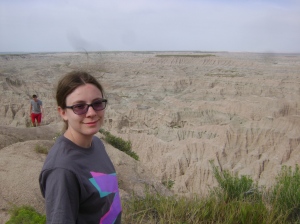
Stacey at the Badlands overlook
When we finally got to the overlook, the view was spectacular. The Badlands is an area composed of extremely soft sedimentary layers which have been eroded, leaving spectacular canyons, ravines, gullies, buttes, and mesas. The Badlands are a bit of a problem for the idea that the earth is billions of years old. The landforms and geology fit much better with the Biblical young-earth timeframe. The layers would have been rapidly deposited during the Great Flood, and quickly eroded immediately after, leaving the sharp landforms. If the process had taken millions of years, the landforms would be far flatter, lacking the sharp vertical structures, due to the extremely soft sediments.
Our last stop of the day was at the Wounded Knee Cemetery and Memorial. Wounded Knee is the site of two significant events in Lakota history. The infamous Wounded Knee Massacre occurred in 1890. On December 28, 1890, a detachment of the U.S. 7th Cavalry Regiment under the command of Major Samuel M. Whitside intercepted a band of Miniconjou and Hunkpapa Lakota near the modern-day town of Porcupine, and escorted them five miles westward to Wounded Knee Creek, where they made
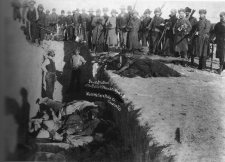
Mass grave at wounded Knee, January, 1891
camp. The 7th Cavalry was the same unit that had been obliterated under General Custer at the Battle of Little Big Horn. The next morning, while attempting to disarm the Lakota, a shot was accidentally fired; the soldiers opened fire indiscriminately from all sides, killing men, women, and children, as well as some of their own fellow soldiers. The surviving Lakota fled, but U.S. cavalrymen pursued and killed between 200 and 300 Lakota, and wounded at least 51, most of whom were unarmed women, children, and elderly. Following a three-day blizzard, the military hired civilians to gather the frozen bodies and heap them in a mass grave on the hillside overlooking the massacre site. This event essentially ended all resistance to the Reservation system, and put into motion events that have led to the deplorable conditions that exist on the reservation to this day.
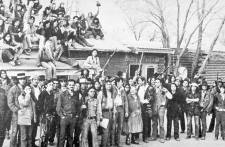
Wounded Knee, 1973
The second incident, 83 years after the massacre, began on February 27, 1973, when approximately 200 Oglala Lakota and followers of the American Indian Movement (AIM) seized and occupied the town of Wounded Knee, just a few yards south of the massacre site. The occupation was part of an internal political struggle within the Lakota tribe, but was also a protest against the United States government’s failure to fulfill treaties with Native people and demanded the reopening of treaty negotiations. Oglala and AIM activists controlled the town for 71 days while the United States Marshals Service, FBI agents, and other law enforcement agencies cordoned off the area. The internal tribal political conflict continues to this day, with traditionalists pitted against progressives for control of the tribe.
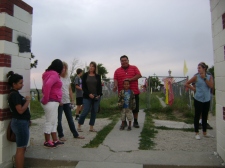
John and Nadine talk to the group at Wounded Knee
John and Nadine Bissonette joined our group at the cemetery to share their personal stories. I didn’t write down all the details, but one of Nadine’s great grandparents was present at the Massacre of Wounded Knee. I don’t remember whether she said her ancestor was a survivor, or whether they died during the massacre. John’s family was very involved with the 1973 incident. His uncle Pedro Bissonette was the director of the Oglala Sioux Civil Rights Organization (OSCRO), who, along with AIM, occupied the town of Wounded Knee. In the aftermath of the incident, more than 60 opponents of the tribal government died violently, including John’s uncle Pedro Bissonette, his aunt Gladys Bissonette, and his mother Jeanette Bissonette. John was a toddler when his mother was murdered in her car by a sniper, with John in the back seat. Her murder remains unsolved.
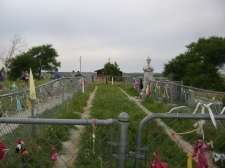
The mass grave at Wounded Knee
The visit to the Wounded Knee Memorial was a very somber event for me. The massacre was a pivotal point in the long history of oppression the Lakota have suffered. The aftershocks of Wounded Knee are still felt on the Rez. It reminded me of why I went to Pine Ridge: the people of Pine Ridge have suffered for many years, and desperately need the hope that only Jesus Christ can provide.
That evening, one of Cody White Pipe’s sisters stopped by the Next Step compound to say goodbye to our group. I wasn’t involved, but some of our group talked with her late into the night and shared the Gospel.
As I spent my last night in my cot at the Next Step compound, I prayed that the work we had done and the relationships we had built had brought hope to someone, and that somehow my visit to Pine Ridge would be used by God to bring someone closer to knowing Jesus Christ as Savior.
Filed under: About Me, Ministry, Mission Trips, Personal Logs, Pine Ridge Reservation | Tagged: culture, demons, evangelism, Gospel, Lakota, Mission Trip, Pine Ridge, Short-term mission, Wounded Knee | Leave a comment »


